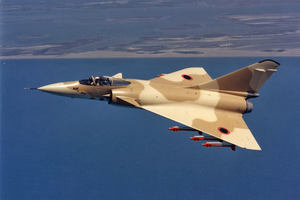NA107 Chainbreaker: Difference between revisions
mNo edit summary |
mNo edit summary |
||
| Line 31: | Line 31: | ||
==Development== | ==Development== | ||
The NA48 Chainbreaker was developed from the single-engine {{wp|Mirage 2000|NA28 Spirit Wind}} and shares a considerable number of commonalities with the older aircraft. Despite this, the Chainbreaker is considerably larger and heavier than its predecessors. The design of the airframe was completed in the mid-1990s and production began in 1997. The first test flight took place in May of 1998. After its success, full production of the airframes was commenced that year, though the aircraft was only officially brought into service after the sensors and avionics were successfully selected and installed in 2004. | |||
===Origin=== | ===Origin=== | ||
After the introduction of the NA28/36 Sunray in 1986, the Talaharan Air Corps relied on three different mainline fighter aircraft, including both variants of the NA28 and the aged {{wp|Dassault Mirage II|NA6 Tiara}} which had originally entered into service in 1961. By 1990, the Talaharan Air Corps was preparing for the retirement of the Tiara and required a new | |||
===Prototype=== | ===Prototype=== | ||
Revision as of 06:09, 14 November 2022
This article is incomplete because it is pending further input from participants, or it is a work-in-progress by one author. Please comment on this article's talk page to share your input, comments and questions. Note: To contribute to this article, you may need to seek help from the author(s) of this page. |
| NA48 Chainbreaker | |
|---|---|

| |
| Role | Multirole/air superiority fighter |
| National origin | Talahara |
| Manufacturer | United Aeronautics Syndicate |
| First flight | 9 March 1998 |
| Introduction | 18 May 2004 |
| Status | In service |
| Primary user | Talaharan Air Corps |
| Produced | 1998–present |
| Number built | 182 |
| Program cost | $14 billion |
| Unit cost |
$70 million
|
| Developed from | NA28 Spirit Wind |
The NA48 Chainbreaker (Takelat: ⵏⴰ48 ⵔⴰⵣⴰⵜⵉⵙⵦⵏⵙⴰⵍⴰⵏ; NA48 Razatisensalan) is a twinjet, canard, delta-wing, multirole combat fighter. The Chainbreaker is generally regarded as a 4.5++ generation aircraft, equipped with advanced sensors and avionics with limited stealth design, and capable of engaging in supremacy, interdiction, reconnaissance, close air support, and anti-ship warfare missions.
Developed from the NA28 Spirit Wind, the Chainbreaker was intended to consolidate the roles of the NA28 Spirit Wind and the NA28/36 Sunray in a modern platform. The airframe first flew in 1998, but the development of the aircraft's systems delayed its official introduction to 2004. While primarily a domestic project, the full avionics and sensor suite was developed with a number of foreign resources and technologies.
Following its introduction, the Chainbreaker was marketed for export to a limited number of socialist republics worldwide. The Talaharan Air Corps remains the primary user of the aircraft, in addition to the Tyreseian Workers' Naval Air Service.
Development
The NA48 Chainbreaker was developed from the single-engine NA28 Spirit Wind and shares a considerable number of commonalities with the older aircraft. Despite this, the Chainbreaker is considerably larger and heavier than its predecessors. The design of the airframe was completed in the mid-1990s and production began in 1997. The first test flight took place in May of 1998. After its success, full production of the airframes was commenced that year, though the aircraft was only officially brought into service after the sensors and avionics were successfully selected and installed in 2004.
Origin
After the introduction of the NA28/36 Sunray in 1986, the Talaharan Air Corps relied on three different mainline fighter aircraft, including both variants of the NA28 and the aged NA6 Tiara which had originally entered into service in 1961. By 1990, the Talaharan Air Corps was preparing for the retirement of the Tiara and required a new